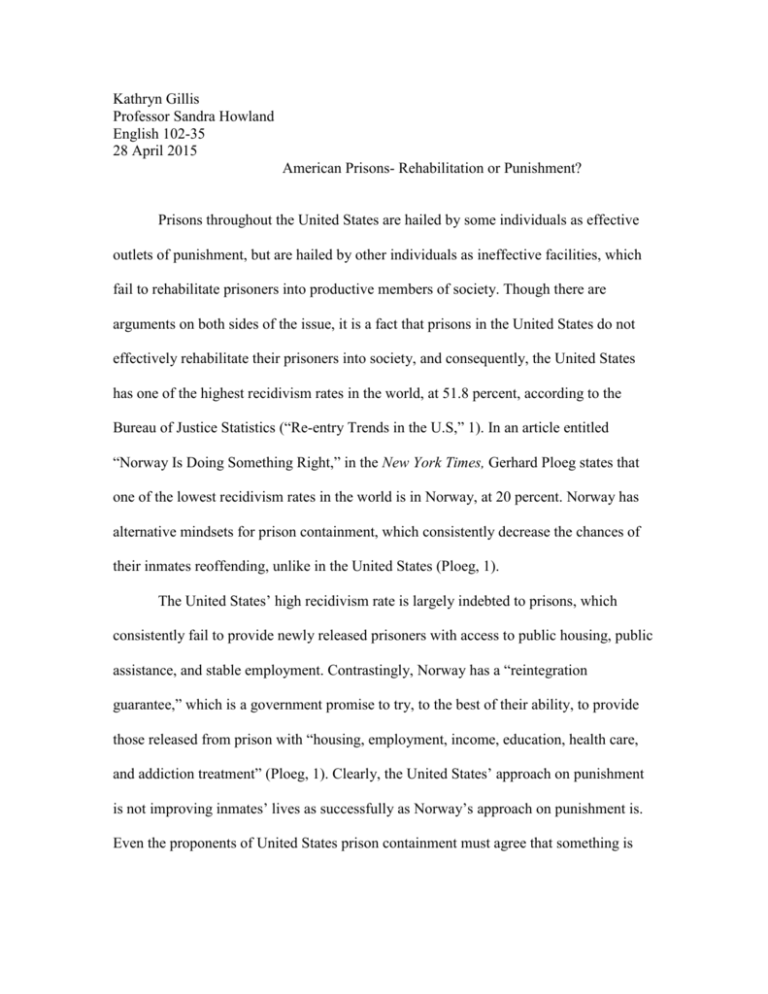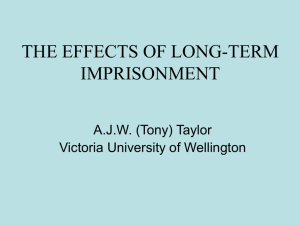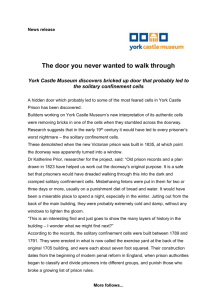American Prisons- Rehabilitation or Punishment?
advertisement

Kathryn Gillis Professor Sandra Howland English 102-35 28 April 2015 American Prisons- Rehabilitation or Punishment? Prisons throughout the United States are hailed by some individuals as effective outlets of punishment, but are hailed by other individuals as ineffective facilities, which fail to rehabilitate prisoners into productive members of society. Though there are arguments on both sides of the issue, it is a fact that prisons in the United States do not effectively rehabilitate their prisoners into society, and consequently, the United States has one of the highest recidivism rates in the world, at 51.8 percent, according to the Bureau of Justice Statistics (“Re-entry Trends in the U.S,” 1). In an article entitled “Norway Is Doing Something Right,” in the New York Times, Gerhard Ploeg states that one of the lowest recidivism rates in the world is in Norway, at 20 percent. Norway has alternative mindsets for prison containment, which consistently decrease the chances of their inmates reoffending, unlike in the United States (Ploeg, 1). The United States’ high recidivism rate is largely indebted to prisons, which consistently fail to provide newly released prisoners with access to public housing, public assistance, and stable employment. Contrastingly, Norway has a “reintegration guarantee,” which is a government promise to try, to the best of their ability, to provide those released from prison with “housing, employment, income, education, health care, and addiction treatment” (Ploeg, 1). Clearly, the United States’ approach on punishment is not improving inmates’ lives as successfully as Norway’s approach on punishment is. Even the proponents of United States prison containment must agree that something is wrong with the American system, due to the fact that the system is failing to work in a productive manner. Unlike in Norway, prisoners in the United States are kept in cells, with restricted freedom. Inmates are kept in open areas in Norway, and “are considered [to be] part of the community” rather than being ostracized from society (Ploeg, 1). Prisoners in Norway are equipped with more well-trained prison officers during their incarceration, as they must undergo “two years of training,” which includes a “curriculum consist[ing] of penitentiary training, … psychology, sociology, [and] law and social work..” (Ploeg, 1). This multi-disciplinary background enables prison officers to better understand and aid inmates during and after the incarceration process. In Germany, the function of prison is to “enable prisoners to lead a life of social responsibility free from crime upon release,” as quoted in “Lessons from European Prisons,” written by the editorial board of the New York Times. If United States prisoners who are released back into society are not able to access programs that counteract the chances of them re-offending, how can authorities expect prior inmates to live “free from crime,” as they are expected to in Germany? As these inmates are not being afforded enough services that allow them to rehabilitate into society, they simply cannot become instantly rehabilitated without access to these crucial services. For this reason, European inmates have more successful lives after incarceration than American inmates. Unfortunately, prisons in the United States have an incentive to incarcerate prisoners, as Angela Davis explains in her article, “Masked Racism: Reflections on the Prison Industrial Complex,” due to the “profitable investment” (Davis, 571) that encourages individuals to invest in prisons by holding stock. This incentive is a conflict of interest that affects the lives of the prison’s inmates, because the priority of pleasing stockholders is placed before the welfare of the prison’s incarcerated individuals. Prison privatization has only increased the instances of corruption and abuse of power from individuals who are judicial administrative figures and prison employees. Such instances of greedy and self-interested behavior parallel the continuing deterioration of the American prison system. In the American state of Pennsylvania, two judges named Mark Ciavarella and Michael Conahan accepted bribes from a private prison company, Mid-Atlantic Youth Services Corporation, in exchange for inflicting prison sentences on many young individuals, as reported in the CNN article “Pennsylvania Rocked by ‘jailing kids for cash’ scandal” by Stephanie Chen. The judges received over 2.6 million dollars combined (Chen, 3). Attorneys for the owner of Mid-Atlantic Youth Services Corporation, Robert Powell, have stated that Powell is one of the individuals who paid the judges, though they allege that Powell did not supply the judges with the bribe money willingly, as he was “pressured by the judges” into doing so (Chen, 5). It is disheartening to discover that appalling behavior such as this occurs in America’s justice system – which is supposed to be a system that prides itself on its’ equal and fair judicial decisions. If some of the most important officials are corrupt, how are individuals in America supposed to trust in their justice system? One controversial prison practice in the United States, solitary confinement, was envisioned as a way to engage prisoners in self-reflection and bestow in them a new attitude, through individual betterment and contemplation of their acts. Though some prisoners in current-day prisons in the United States participate in programs that do change their emotional and mental outlook, the practice of solitary confinement does not improve the well-being of inmates. The United Nations Rapporteur on Crime, Juan Mendez, has stated that the practice of holding prisoners in solitary confinement for a period of time which “exceed[s] 15 days should be prohibited,” according to the article, “This Is America? Men Tortured in Solitary for Having the Wrong Tattoo or Political Books,” written by Charlotte Silver for ‘AlterNet’. Sadly, some individuals have stayed in solitary confinement for decades. The maintenance of the cells, its’ dimensions, and the extreme isolation can lead an individual to believe that “it’s like being locked in your bathroom [,] for years,” said Leslie Walker, the executive director of Prisoners’ Legal Services. According to the article, “The Cruel Rise of Solitary Confinement in America,” by Andrew Gumbel, when author Charles Dickens visited Eastern State Penitentiary’s solitary confinement areas in Pennsylvania, he concluded that prisoners held there suffered from visions, desperation, lack of concentration, and the loss of their identities (Gumbel, 1). In Michel Foucault’s article on “Panopticism,” he states that inmates are “deprive[d] of light,” and are “hid[den]” from view (182). If indeed solitary confinement practices are a necessary evil, efforts can be made to make the accommodations more accepting, such as adding more light, being more open and larger, and having less isolation from other inmates. Would one rather be at a prison in the United States or in Norway? Due to both of their practices, the answer is quite clear. One could argue that being held in solitary confinement could violate the constitution’s law that no individual must suffer “cruel and unusual punishment.” Is it not true that these prisoners slowly but surely, lose their minds in solitary confinement? Is this punishment cruel or justified? Truly, an excess of fifteen days in solitary qualifies as cruel and unusual punishment. An access to education is crucial in order to deter and decrease the chances of individuals committing crimes, and consequently, many individuals who are incarcerated have not attained a high education level. Some prison programs in the United States strive to give inmates access to free books, workshops, and other services. In the article, “Incarceration and Recidivism…,” by Carolyn W. Deady, she mentions a study conducted by the Vera Institute of Justice which concluded that out of forty American states in 2010, the “annual average public cost [per inmate] was… $31,286…” (Deady, 2). Sadly, the “average cost [spent] per public school student [nationwide] was $11,184…” (Deady, 2). Does it not make more sense if American states simply spend more money on education for students, rather than spending more money in the future for prisoners who need access to education in order to overcome the cycle of violence? This cycle can be prevented by using common sense and by experimentation. If European countries can alter crime rates positively, the United States should be able to as well. Foucault states in “Panopticism,” that prisons “resemble…schools,” because of the stringent policies students are expected to adhere to in order to do well academically (206). If schools focused more on education and less on disciplining students for minor infractions, the ‘school-to-prison-pipeline’ would occur less in schools nationwide. I concur with Angela Davis, the author of “Masked Racism…,” when she states that “…what we need is not new prisons, but new health care, housing, education, drug programs, jobs, and education” (573). The cycle of keeping and increasing the amount of prisoners in prisons is also enforced by a percentage of a group of individuals who have an incentive to keep the level of prison inmates high. Police officers are promoted on how many arrests they obtain, prosecutors are awarded for how many convictions they gain, and other officials take bribes or engage in other forms of opportunism in order to profit from prisoners. This mindset puts personal achievement above the preferable achievement of serving and caring about a community. This dangerous trend affects every American citizen, even those who are not incarcerated. If one cannot trust authoritative figures in government, law, and in public safety, who can one trust? It is extremely apparent that instances of corrupt behavior must be investigated and discovered in order to help improve the American justice system, and it is a reality that American citizens must be willing to support individuals who are part of the justice system, including prisoners and authoritative figures, in order to ameliorate American communities and families. The cost that the United States spends per prisoner each year is reflective of the fact that the justice system in the United States is just not working- as there are many individuals who are apprehended multiple times, and are reintegrated back into the prison system. The money United States taxpayers spend is, unfortunately, not actually altering the justice system in a positive way, as the system is not improving for the better. If the United States could develop an alternative to prison containment more similar to Norway’s, it could lower the United States’ recidivism rate, and the United States would become better rehabilitated, focusing on more improved rehabilitation, instead of on unproductive punishment. Works Cited Page Bureau of Justice Statistics, Office of Justice Programs. “Re-entry Trends in the U.S.” 1 March 2003. Web. 28 April 2015. Chen, Stephanie. Cable News Network. “Pennsylvania Rocked by ‘jailing kids for cash’ scandal.” 24 February 2009. Web. 28 April 2015. Davis, Angela. “Masked Racism: Reflections on the Prison Industrial Complex.” Fall, 1998. Article. 28 April 2015. Deady, Carolyn W. Salve Regina University- Pell Center. “Incarceration and Recidivism: Lessons from Abroad.” March 2014. Web. 28 April 2015. Editorial Board. New York Times. “Lessons from European Prisons.” 7 November 2013. Article. 28 April 2015. Foucault, Michel. “Discipline and Punish- Panopticism.” 1975. Chapter in Text. 28 April 2015. Gumbel, Andrew. Los Angeles Review of Books. “Cruel Rise of Solitary Confinement in America.” 11 October 2013. Web. 28 April 2015. Ploeg, Richard. New York Times. “Norway is Doing Something Right.” 18 December 2012. Article. 28 April 2015. Silver, Charlotte. AlterNet. “This is America? Men Tortured in Solitary for Having the Wrong Tattoo or Political Books.” 6 November 2013.Web. 28 April 2015. Walker, Leslie. Prisoners’ Legal Services of Massachusetts. “Alone in The Dark: Solitary Confinement Reform in Massachusetts Prisons.” 1 August 2013. Web. 28 April 2015.






